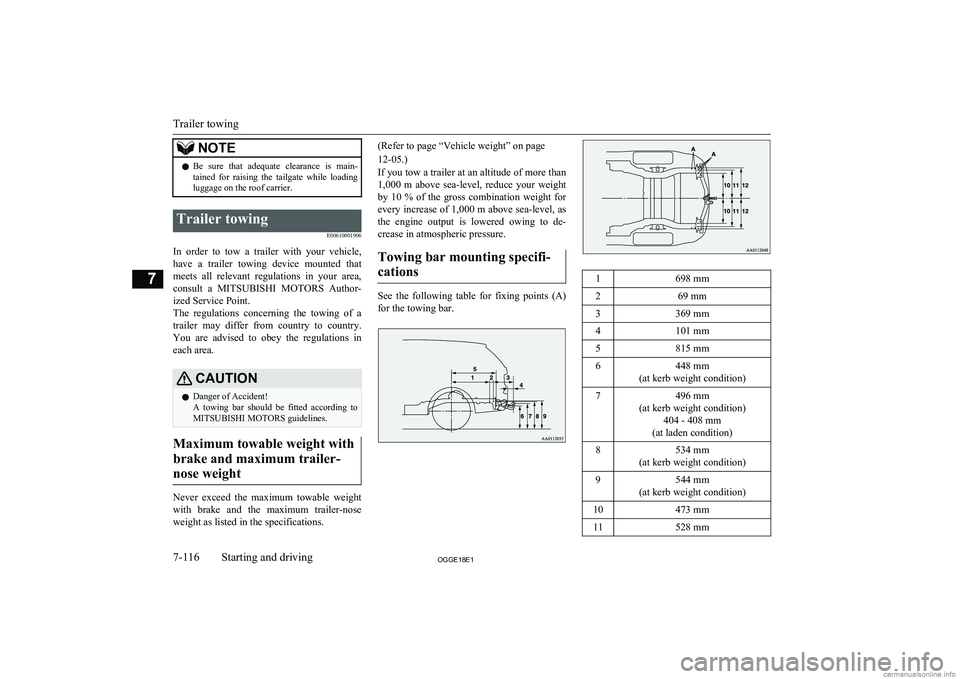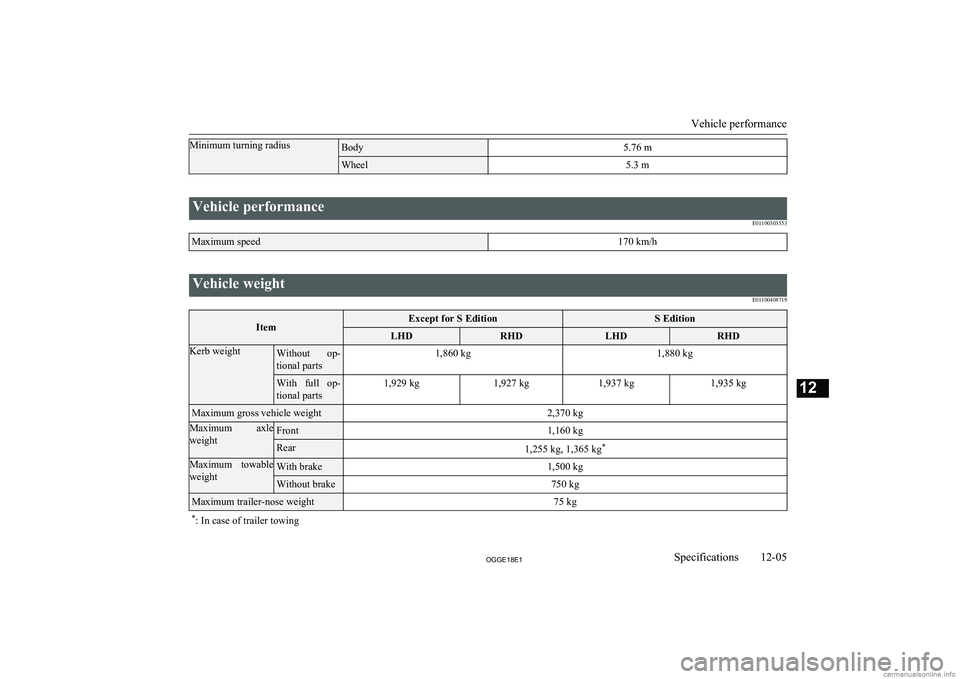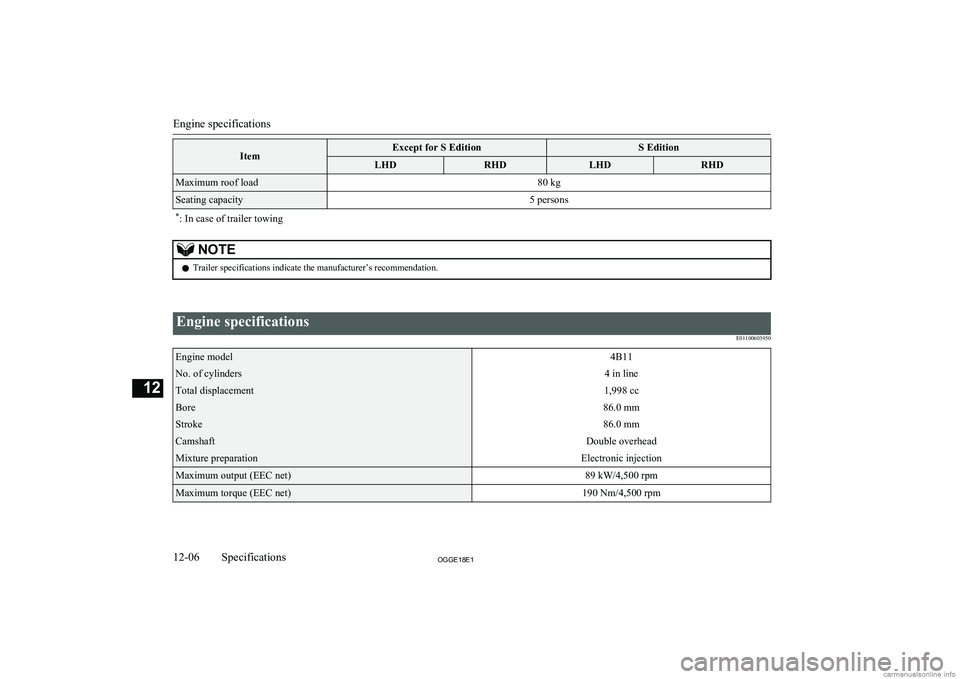2018 MITSUBISHI OUTLANDER PHEV trailer
[x] Cancel search: trailerPage 215 of 538

Economical driving............................................................................. 7-02
Driving, alcohol and drugs.................................................................. 7-02
Safe driving techniques....................................................................... 7-02
Parking brake...................................................................................... 7-03 Parking................................................................................................ 7-06
Steering wheel height and reach adjustment....................................... 7-07
Inside rear-view mirror....................................................................... 7-07
Outside rear-view mirrors................................................................... 7-09
Power switch....................................................................................... 7-12 Starting and stopping the Plug-in Hybrid EV System........................ 7-14
Selector lever (Joystick type).............................................................. 7-16 Select position indicator...................................................................... 7-17
Electrical Parking switch.................................................................... 7-18
Regenerative braking level selector (paddle type)*............................ 7-19
S-AWC (Super All Wheel Control).................................................... 7-21
4-wheel drive operation...................................................................... 7-23
Inspection and maintenance following rough road operation............. 7-24
Cautions on handling of 4-wheel drive vehicles................................. 7-24
EV switch............................................................................................ 7-25
Battery save mode switch................................................................... 7-27
Battery charge mode switch................................................................ 7-28 Acoustic Vehicle Alerting System (AVAS)....................................... 7-29
Braking................................................................................................ 7-30
Brake auto hold................................................................................... 7-32
Hill start assist..................................................................................... 7-34
Brake assist system............................................................................. 7-35
Emergency stop signal system............................................................ 7-36
Anti-lock brake system (ABS)............................................................ 7-36
Electric power steering system (EPS)................................................. 7-39Active stability control (ASC)............................................................ 7-40
Cruise control*.................................................................................... 7-42
Speed Limiter*.................................................................................... 7-47
Adaptive Cruise Control System (ACC)*...........................................7-52 Forward Collision Mitigation System (FCM)*...................................7-64Ultrasonic misacceleration Mitigation System (UMS)*..................... 7-74Blind Spot Warning (BSW) (with Lane Change Assist)*.................. 7-79
Rear Cross Traffic Alert (RCTA)*..................................................... 7-83Lane Departure Warning (LDW)*...................................................... 7-85
Tyre pressure monitoring system (TPMS).......................................... 7-89 Reversing sensor system*................................................................... 7-94
Parking sensors (Front/Rear)*............................................................ 7-98
Rear-view camera*........................................................................... 7-102 Multi Around Monitor*.................................................................... 7-106
Cargo loads....................................................................................... 7-115 Trailer towing....................................................................................7-116Starting and driving
OGGE18E17
Page 270 of 538

CAUTIONcannot detect the vehicle in front properly, in
the following situations.
• When a vehicle cuts in front of your vehi-
cle very closely.
• When a vehicle in front is offset to the left
or right.
• When a vehicle in front is towing a trailer.
• The vehicle in front is moving at a speed
much lower than your vehicle’s.
• A motorcycle or a bicycle.
• A freight trailer that is not carrying a con-
tainer.
• The vehicle has a protruding load from
the carrier.
• When the vehicle has a low weight.
• When the vehicle has an extremely high
ground clearance.
• When there is repeated steep uphill and
downhill driving.
• When driving on an irregular or uneven
road surface.
• When being driven in a tunnel.
• When you are carrying extremely heavy
loads in the rear seats or luggage area.
• When the Plug-in Hybrid EV System is
starting.
• When driving in curved sections of road
including their entrance/outlet or running
beside a closed lane in a traffic work or
similar zone.
• When the cover part in front of the sensor
and the sensor become dirty or have snowand ice adhering to it*.CAUTION• When water, snow or sand on the road are
extorted by the vehicle in front or an on- coming vehicle*.
*: After the ACC control has been cancelled
automatically due to detection of a state of decline in performance, the ACC will notoperate in the temporary condition and will
inform the driver by buzzer and indication.
When the ACC is in the state in which it can
operate, indication is cancelled. Should indi- cations not be cancelled, then there is a pos- sible abnormality in the system.
Please contact a MITSUBISHI MOTORS
Authorized Service Point.Cruise control switch
E00634801054
1- “ACC ON/OFF” switch
Used to turn on and off ACC or the
cruise control function.
2- “SET -” switch
Used to set a desired speed and to reduce the set speed.
3- “RES +” switch
Used to make ACC operate at the origi-
nally set speed and also to increase the set speed.
4- “CANCEL” switch
Used to cancel the control function of
ACC or the cruise control.
5- ACC distance switch
Used to change the setting of the follow-
ing distance between your vehicle and a
vehicle in front.NOTEl Operate the individual switches correctly
and one after another.
The ACC may be turned off or its control
function may be cancelled if two or more switches are pressed concurrently.
Adaptive Cruise Control System (ACC)*
7-56OGGE18E1Starting and driving7
Page 280 of 538

Once the emergency braking has worked, you
are alerted to this by a message on the infor- mation screen of the multi-information dis- play.
The FCM braking function operates at the
following vehicle speed:
l Against a vehicle: Approximately
5 km/h (3 mph) to 80 km/h (50 mph).
l Against a pedestrian: Approximately
5 km/h (3 mph) to 65 km/h (40 mph).
CAUTIONl Do not use the FCM as a normal braking.
l After your vehicle has stopped following the
activation of the FCM, automatic braking is released. As the vehicle will then start creep-
ing, be sure to depress the brake pedal to
hold the vehicle stationary.CAUTIONl When applying the brake during the auto-
matic braking condition the pedal will feel firm.
This is not abnormal.
You can apply more pressure to the pedal to
assist in braking.
l In the following situations, the system pro-
vides neither control nor alarming.
• When a vehicle or a pedestrian suddenly
cuts in front of your vehicle.
• When the distance from a vehicle or a pe-
destrian in front is extremely short.
• To an oncoming vehicle.
• When the select position is in the “P”
(PARK) or the “R” (REVERSE) position.
• When the FCM has detected a problem in
the system.
l If the ASC is deactivated, the FCM braking
function will not operate. Refer to “Active
Stability Control (ASC)” on page 7-40.
l The FCM may or may not detect a motorcy-
cle, bicycle or wall depending on the situa-
tion. The FCM is not designed to detect these objects.
l The forward collision warning function
and/or the FCM braking function may not
activate in the following situations.
• When a vehicle suddenly appear just in
front of your vehicle.
• When a vehicle cuts in front of your vehi-
cle very closely.
• When the vehicle in front is offset to the
left or right.CAUTION• When the vehicle in front is towing a
trailer.
• A freight trailer that is not carrying a con-
tainer.
• The vehicle has a protruding load from
the carrier.
• The vehicle has a low vehicle height.
• The vehicle has an extremely high ground
clearance.
• When a vehicle in front is extremely dirty.
• When a vehicle in front is covered with
snow.
• When a vehicle in front has a large glass
surface.
• When a vehicle in front does not have re-
flectors (lamp reflector) or the position of the reflector is low.
• When a vehicle in front is a car carrier or
a similar shaped vehicle.
• When there is a different object near the
vehicle.
• When driving on a road with many and
successive curves, including when pass-
ing their entrances and outlets.
• When accelerating and decelerating
quickly.
• When the system recognizes driver’s
steering, accelerating, braking or gear
shifting actions as evasive actions to
avoid collision.
• When you are driving on a road with
steep and alternating up and down slopes.
• When driving on a slippery road covered
by rain water, snow, ice etc.
Forward Collision Mitigation System (FCM)*
7-66OGGE18E1Starting and driving7
Page 292 of 538

CAUTIONlImproperly handling the system components may result in such problems as degraded sensor performance and ultimately in an accident.
Be sure to take the following precautions to keep the system in good operating conditions.
• Avoid application of strong shock loads to the sensor.
• The sensor should be kept clean.
• Do not cover the sensor with a sticker or anything.
• Do not modify the suspension of your vehicle.
l If the bumper has been exposed to an impact, the sensors may fail and prevent the system from functioning properly. Have the vehicle inspected a
MITSUBISHI MOTORS Authorized Service Point.
Obstacle detection areas
E00643500047
The detection areas of the sensors are limited.
Moreover, the sensors are unable to detect
low or thin objects or objects near the rear
bumper. Make sure to check the surroundings
as you operate the vehicle in a safe manner.
Sensor locations
E00643600165
There are the sensors (A) on each of four pla-
ces of the front bumper and the rear bumper.CAUTIONl The UMS may not operate because the sen-
sor cannot detect the vehicle in front or ob-
stacle as follows.CAUTION• Vehicle towing a trailer etc.
• A freight trailer that is not carrying a con-
tainer.
• Vehicle that has a protruding load from
the carrier.
• An obstacle with a low height.
• Vehicle that has an extremely high ground
clearance.
• Vehicle that is extremely stained.
• Vehicle or obstacle that is covered with
snow.
• The vehicle is the specific shape such as
the carrier car.
• Obstacles that have the shape of the pole
such as the road marker or the streetlight.
• Obstacles that exists in the high position
from the ground.
• Obstacles that are soft and absorb ultra-
sonic easily, such as spongy material or
snow.
Ultrasonic misacceleration Mitigation System (UMS)*
7-78OGGE18E1Starting and driving7
Page 330 of 538

NOTElBe sure that adequate clearance is main-
tained for raising the tailgate while loading
luggage on the roof carrier.Trailer towing
E00610001906
In order to tow a trailer with your vehicle,
have a trailer towing device mounted that
meets all relevant regulations in your area, consult a MITSUBISHI MOTORS Author-
ized Service Point.
The regulations concerning the towing of a
trailer may differ from country to country. You are advised to obey the regulations in
each area.
CAUTIONl Danger of Accident!
A towing bar should be fitted according to MITSUBISHI MOTORS guidelines.
Maximum towable weight with
brake and maximum trailer- nose weight
Never exceed the maximum towable weight
with brake and the maximum trailer-nose weight as listed in the specifications.
(Refer to page “Vehicle weight” on page
12-05.)
If you tow a trailer at an altitude of more than
1,000 m above sea-level, reduce your weight by 10 % of the gross combination weight for
every increase of 1,000 m above sea-level, as
the engine output is lowered owing to de-
crease in atmospheric pressure.
Towing bar mounting specifi-cations
See the following table for fixing points (A) for the towing bar.
1698 mm269 mm3369 mm4101 mm5815 mm6448 mm
(at kerb weight condition)7496 mm
(at kerb weight condition) 404 - 408 mm
(at laden condition)8534 mm
(at kerb weight condition)9544 mm
(at kerb weight condition)10473 mm11528 mm
Trailer towing
7-116OGGE18E1Starting and driving7
Page 331 of 538

12583 mm
Operating hints
lBe sure that the driving speed does not
exceed 100 km/h (62 mph) for trailer op-
eration. It is also recommended that you obey the local regulations in case driving speed with a trailer is limited to less than
100 km/h (62 mph).
l To prevent shocks from the overrun
brake, depress the brake pedal lightly at first and then more strongly.
Overheating
This will normally occur as a result of some
mechanical failure. If your vehicle should overheat, stop and check for a loose or bro-ken water pump/alternator drive belt, a
blocked radiator air intake or a low coolant level. If these items are satisfactory the over-
heating could be caused by a number of me-
chanical causes that would have to be
checked at a competent service centre.
CAUTIONl If the engine overheats, reference should be
made to “Engine overheating” section of
“For emergencies” prior to taking any cor- rective action.Parking
It is not recommended to park on a steep
slope while towing trailer.
If parking on a steep slope cannot be avoided,
the road grade should be less than 12% and
the following procedure performed. 1. Apply the parking brake firmly on the
vehicle and the trailer (if fitted).
2. Put the select position in “P”.
3. Place chocks or blocks at the tyres on
both vehicle and trailer.
4. Turn the front wheels into the shoulder
of the road to prevent the vehicle from moving.
Driving on long up hills while towing trailer
When the remaining quantity of the drive bat-tery is low, or high-speed driving on long up
hills at high temperature, the drive battery
output is restricted and the vehicle speed may be decreased.
The vehicle speed may be recovered if the
drive battery quantity is recovered.
NOTEl In charge mode, if the remaining quantity of
the drive battery can be increased in ad-
vance, it can prevent the vehicle speed from
decreasing on long up hills.
Refer to “Battery charge mode switch” on page 7-28.
Trailer towing
7-117OGGE18E1Starting and driving7
Page 483 of 538

Minimum turning radiusBody5.76 mWheel5.3 m
Vehicle performanceE01100303553Maximum speed170 km/h
Vehicle weightE01100408719ItemExcept for S EditionS EditionLHDRHDLHDRHDKerb weightWithout op-tional parts1,860 kg1,880 kgWith full op- tional parts1,929 kg1,927 kg1,937 kg1,935 kgMaximum gross vehicle weight2,370 kgMaximum axle
weightFront1,160 kgRear1,255 kg, 1,365 kg *Maximum towable
weightWith brake1,500 kgWithout brake750 kgMaximum trailer-nose weight75 kg* : In case of trailer towing
Vehicle performance
12-05OGGE18E1Specifications12
Page 484 of 538

ItemExcept for S EditionS EditionLHDRHDLHDRHDMaximum roof load80 kgSeating capacity5 persons*: In case of trailer towingNOTEl Trailer specifications indicate the manufacturer’s recommendation.
Engine specifications
E01100603950Engine model4B11No. of cylinders4 in lineTotal displacement1,998 ccBore86.0 mmStroke86.0 mmCamshaftDouble overheadMixture preparationElectronic injectionMaximum output (EEC net)89 kW/4,500 rpmMaximum torque (EEC net)190 Nm/4,500 rpm
Engine specifications
12-06OGGE18E1Specifications12